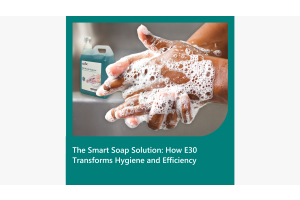Blog
-
April 22, 2025
Selecting the right protective gloves is crucial when working in environments with thermal hazards. In Australia, the standard governing gloves for thermal protection is AS/NZS 2161.4:1999, which aligns with the European EN 407 standard.
This standard evaluates gloves based on six specific thermal risks, each rated on a scale from 0 to 4, with higher numbers indicating better protection.
Each glove tested under this standard will display a pictogram followed by a six-digit code, with each digit representing the glove's performance level in the corresponding category.
For example, a glove marked with "41234X" indicates varying levels of protection across the six categories, with "X" signifying that the glove was not tested for the sixth category.
For instance, this multi-purpose Maxi-safe gauntlet glove, DGH-1154 -
February 27, 2025
In the fast-paced food industry, every second counts. Efficiency, hygiene, and cost-effectiveness are paramount, especially when it comes to something as fundamental as hand hygiene. Traditional liquid soap dispensers may seem like a simple solution, but they come with hidden costs and inefficiencies. Enter the E30 soap system—a game-changer in hand hygiene that lasts 700% longer than standard refillable dispensers while streamlining operations and reducing waste.
The Problem with Traditional Liquid Soap Dispensers
Refillable liquid soap dispensers are widely used, but they come with several downsides:- Labour Intensive: Manually refilling dispensers takes time and effort, diverting staff from critical
-
October 18, 2024
Standing orders are common throughout many industries - but especially valuable for the food industry – as running out of production critical consumables isn’t an option.
A standing order is simply determining how much stock you need over a certain period. It is usually set to a fixed time of ordering, such as once a week, fortnight, or month, to ensure the stock quantities on hand are sufficient.
The advantage of standing orders is that you can still place an ad hoc order when required, but it ensures that most of the time, stock is consistent and adequate.
Convenience: Ad hoc ordering is usually time-consuming and unpredictable. Standing orders, however, remove the need for constant checking and juggling stock. Creating a pattern or structure gives you confidence that you always have the stock you need on hand. This saves you time so you can focus on your other priorities.Cost Savings: Standing orders are more cost-effective for
-
July 31, 2024
In the food industry, choosing between disposable and reusable uniforms and personal protective equipment (PPE) is a decision that impacts hygiene, safety, cost, environmental sustainability, and operational efficiency. This blog explores the pros and cons of both options, providing insights into making the best choice for your business.1. The Role of Uniforms and PPE in the Food Industry
Uniforms and PPE are crucial for:Protection: Safeguarding workers from contamination and potential hazards such as sharp objects or chemical exposure.
Hygiene: Preventing contamination of food products by acting as a barrier between the worker and the food. -
March 28, 2024
Consolidation.
Anyone familiar with purchasing consumables would understand the complexities of ensuring quality products are always available before they are required.
Complexities include the stress of managing multiple suppliers, invoices, deliveries, and backorders, as well as monitoring stock levels whilst also balancing the demand for cost efficiencies with the high-quality standards food processing mandates.
The solution? Consolidation.
Many Corporations use their buying power to navigate contracts and tenders. Consolidation
-
February 15, 2024
The choice of glove for your production area is profuse. Commonly the thickness, colour, and material type are considered to suit your task and ingredients. But have you considered your staff's comfort?
For most staff, gloves are a non-negotiable part of their uniform. For others, however, gloves cause serious discomfort.
The most frequent complaint of reaction to gloves occurs with natural latex gloves. This allergic reaction can include rashes, blisters, and itchiness, or in severe cases – anaphylaxis.
While a rash may seem a minor complaint, reactions often intensify with continued use. There have also been situations where allergic reactions have developed over -
January 17, 2024
The benefit of an account : pricing.
At Foodcare, we value our partnership with our customers belonging to the food and beverage manufacturing industry. As our products and services are dedicated to this industry alone, we offer special pricing across our full range to anyone belonging to the industry. For our longer-standing customers, further price deductions may be arranged with their sales rep.
So, how do you access your correct pricing?
Simply log into your account on our website or create one if you haven’t yet. This will automatically sync to your correct pricing. (New accounts may take a standard business day to be activated.)
If you are not logged in, you will not be accessing our trade pricing, or other agreed upon pricing.
Furthermore, pricing on products varies from time to time. To ensure you have current pricing, -
November 17, 2023
Cleaning is paramount to keeping your food and operations free from contamination, and the tools you use for this greatly impact how protected your food is. It is also key to securing audit compliance and meeting food safety standards.
However, If your tools are not stored and cared for correctly, they can become a contamination risk. This is where 5S Storage Solutions have been designed for the industry. Meaning Sort, Set, Shine, Standardise, and Sustain, it is a globally practiced storage system -
September 15, 2023
Where do I start with colour coding?
What are the non-negotiable contamination risks you need to prevent? It’s these areas that are ideal to begin managing using colour. There’s no right or wrong way to do this, and colour coding is fully customisable to your needs.
Outlined below are some of the common colour coding practices used within the industry. If you are interested in how and why it works, click through to this blog where we outline some tips on implementing it.
Allergen management:
Allergen contamination is a universal concern within the food processing industry, as the consequence of this occurring is -
September 04, 2023
Blue is associated as the food industry colour, as it contrasts the majority of ingredients.
This, of course allows visual detection in the unlikely case of it falling into production. However, the use of coloured PPE has increased within the industry to manage contamination and hygiene risks, with no change to PPE quality or cost.
So, why not just use blue?
Reputational damage from a cross-contamination event is just not an option, not to mention the cost of this on your business. While blue allows for easier foreign object traceability, it doesn’t safe-guard from the possibility of mis-handling product, for example allergens.
This is where colour coded PPE comes in.





